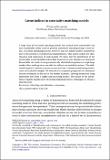Latent indices in assortative matching models
Author(s)
Diamond, William; Agarwal, Nikhil
DownloadDiamond_et_al-2017-Quantitative_Economics.pdf (467.6Kb)
PUBLISHER_CC
Publisher with Creative Commons License
Creative Commons Attribution
Terms of use
Metadata
Show full item recordAbstract
A large class of two-sided matching models that include both transferable and non-transferable utility result in positive assortative matching along a latent index. Data from matching markets, however, may not exhibit perfect assortativity due to the presence of unobserved characteristics. This paper studies the identification and estimation of such models. We show that the distribution of the latent index is not identified when data from one-to-one matches are observed. Remarkably, the model is nonparametrically identified using data in a single large market when each agent on one side has at least two matched partners. The additional empirical content in many-to-one matches is demonstrated using simulations and stylized examples. We then derive asymptotic properties of a minimum distance estimator as the size of the market increases, allowing estimation using dependent data from a single large matching market. The nature of the dependence requires modification of existing empirical process techniques to obtain a limit theorem. Keywords: matching; identification; estimation
Date issued
2017-11Department
Massachusetts Institute of Technology. Department of EconomicsJournal
Quantitative Economics
Publisher
The Econometric Society
Citation
Diamond, William, and Agarwal, Nikhil. “Latent Indices in Assortative Matching Models.” Quantitative Economics 8, 3 (November 2017): 685–728 © 2017 The Authors
Version: Final published version
ISSN
1759-7323
1759-7331